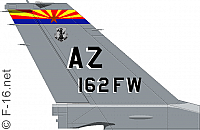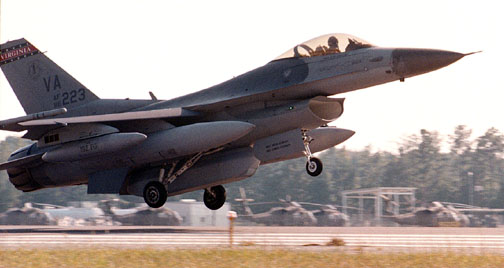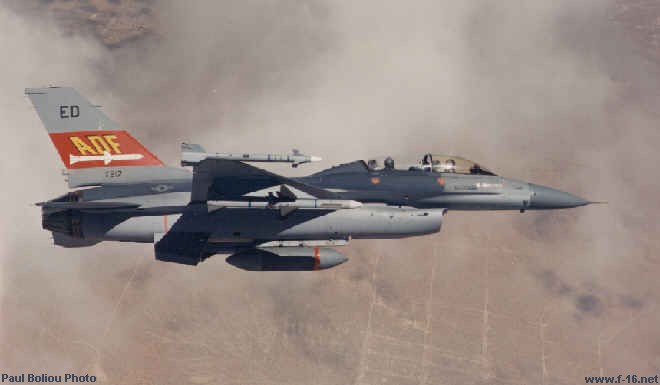 |
United States of AmericaAir National Guard - ANG |
Introduction
The Air National Guard is the largest operator of the F-16 in the US, but also worldwide. It backs up regular USAF units in operations overseas and has a major responsibility in providing defense to the continental US.Inventory
ANG Inventory
In March of 1982, the USAF announced that Air National Guard units would be supplied with F-16A/Bs. The idea was to allow the Air National Guard to take up a more responsibilities in the US Air Force. Hitherto, Air National Guard units, which fall under the authority of the state governor (but can be mobilized and called to active duty by the President or by Congress), had always been considered to be second-string units. They used to receive out-of-date aircraft, handed down to them from other USAF commands. The goal of the new initiative was to turn the ANG into a credible fighting force by supplying it with state-of-the art aircraft and equipment, allowing it to supplement active duty units.
In July 1983, the 169th Tactical Fighter Group of the South Carolina ANG was the first guard unit to receive the F-16, replacing the LTV A-7D in the fighter-attack role. From 1986 onwards, ANG air defense units began to transition to the F-16. The 162nd TFG of the Arizona ANG operated as the training unit for air defense ANG F-16 pilots. The 158th TFG of the Vermont ANG was the first to operate the F-16 in the air defense role, replacing the F-4D Phantom in mid-1986. One of their primary responsibilities was the interception and shadowing of Soviet aircraft flying near US territory.

F-16ADF
One of the Air National Guard's new responsabilities was the aerial defense of the continental United States, previously assigned to the (now-defunct) USAF Air Defense Command. Originally, F-106A Delta Dart interceptors were transferred from the USAF ADC to the ANG. In the mid-1980s, the US Air Force evaluated the General Dynamics F-16 Fighting Falcon and the Northrop F-20 Tigershark as a replacement for the F-106. In October 1986, the decision was made to adopt a modified F-16, designated F-16 ADF (Air Defense Fighter), capable of launching the Sparrow semi-active radar homing BVR missile. The F-16 was selected primarily because it was available in sufficiently large numbers, and could easily be modified to carry the necessary armament. The decision of the USAF to adopt the F-16 for the ADF role was the key reason to cancel the F-20 program.
A total of 271 F-16A/B airframes were to be modified to ADF configuration at the Ogden Air Logistics Center in Utah. Modifications included the installation of a HF radio and an improved APG-66 radar that was compatible with the AIM-7 Sparrow and AIM-120 AMRAAM radar-guided missiles. A spotlight, similar to the one found on Danish and Norwegian aircraft, was to be installed on the port side of the nose to aid in the identification of nighttime intruders. The first rebuilt F-16A/B block 15 ADF aircraft was delivered in early 1989, with the program continuing into 1991. The 114th Tactical Fighter Training Squadron of the Oregon Air National Guard was the first unit to receive the new ADF aircraft. It was followed by the 194th Fighter Interceptor Squadron of the California ANG. F-16s of the Florida ANG fired live AIM-7 missiles for the first time in tests at Tyndall AFB in Florida in June of 1991.
In the early 90s, over 800 F-16A/B/C/D fighters were operating with the various units of the Air National Guard. However, in the mid-1990s the danger of enemy aircraft invading US airspace had diminished, and the US Air Force wanted to discontinue the fighter interceptor role. In the military draw down following the end of the Cold War, many ANG F-16s were withdrawn from service and placed in storage. The first retired F-16A/B's were put in storage at Davis-Monthan AFB in Arizona during 1993, starting with 3 aircraft from the 138th FS of the New York ANG, followed by 17 examples from the 160th FS of the Alabama ANG.

Modifications & Armament
Armament
Air National Guard F-16 ADFs were capable of carrying the AIM-7 Sparrow missile besides the standard AIM-9 Sidewinder. The Sparrow has been replaced by the AIM-120 AMRAAM on newer F-16 models.
ANG F-16s also use the standard USAF weapons such as AGM-88 HARM and GBU-31 JDAM.
F-16s for Close Air Support
In November 1988, the 174th TFW of the New York ANG began replacing their A-10A Thunderbolt II aircraft with the F-16A/B, becoming the first unit to operate the F-16 in a close air support role. Their F-16s were equipped with a 30mm GPU-8/A anti-armor gun pod carried on the centerline pylon. They were deployed to the Persian Gulf during Desert Storm, but they used the gun pod only once during the war. This particular configuration was abolished shortly after the end of the gulf war.
F-16s for Tactical Reconnaissance
A number of guard squadrons use the F-16 in a tactical reconnaissance role. Their F-16s have been modified to accept the TARS pod (Theater Airborne Reconnaissance System).
Modifications and Upgrades
Currently some Guard units are still equipped with Block 15 F-16A/B and ADF models. Most of the units, however, are equipped with the more recent block 25, Block 30/32 and also Block 40/42 models. These block 40/42 aircraft are being upgraded with the CCIP (Common Configuration Implementation Program) enhancement. This modification incorporates a number of systems originally designed for the European MLU program into the existing fleet of USAF Block 40/42/50/52 aircraft. This program started in 1998. The CCIP configuration includes the following systems: Modular Mission Computer, Color Multifunction Display Set, Common Data Entry Electronics Unit, Electronic Horizontal Situation Indicator, Joint Helmet Mounted Cueing System (JHMCS), Link 16 Multifunction Information Distribution System (MIDS) and Low Volume Terminal with TACAN. This modification will allow cost savings through a common type certification and stock savings. This will greatly enhance the fleet's flexibility.
Operational Service
Units
Please refer to the F-16 Units section for an overview of units.Deployments
Air National Guard F-16s have participated in Operation Southern Watch, Operation Northern Watch, Operation Enduring Freedom, Operation Iraqi Freedom, and Operation Noble Eagle.
Please use this form to add any list any error or omissions you find in the above text.
Note: your comments will be displayed immediately on this page. If you wish to send a private comment to the webmasters, please use the Contact Us link.
